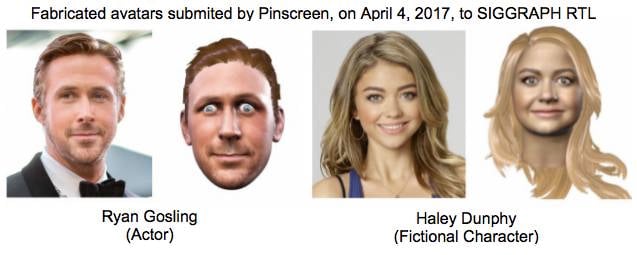This article is more than 1 year old
Techie sues ex-bosses, claims their AI avatar tech was faked – and he was allegedly beaten up after crying foul
Punch up at Cali startup
An engineer is suing Pinscreen, a startup that supposedly uses AI to generate cartoon avatars of people, claiming he was illegally fired and assaulted after confronting the CEO about its allegedly faked technology.
In a court document filed in the Los Angeles County Superior Court, Iman Sadeghi accused his former employer Pinscreen of submitting bogus images and results to SIGGRAPH, a computer graphics conference, and lied to investors.
Screenshots of private Facebook conversations between Sadeghi and Pinscreen’s cofounder and CEO Hao Li show that Li persuaded Sadeghi to join the LA-based startup around November 2016 as vice-president of engineering.
Pinscreen admired Sadeghi’s previous work. He had created the computer generated hairstyles for some of the characters in Tangled, an animated Disney film. Sadeghi left his position at Google, and began working for Pinscreen in February 2017 to help it build software that creates cartoons of people from photographs.
Sadeghi alleged the startup submitted hand-drawn cartoons – rather than AI-made pictures – to SIGGRAPH last year, held in January 2017, specifically “manually prepared hair shapes” instead of software-generated designs.
That conference submission was rejected for being “below the SIGGRAPH standard,” it is claimed, that “a lot of disturbing artifacts can be observed in almost all hair models,” and that the conference organizers had “seriously doubt [that] the quality is good enough for games or VR applications.”
If at first you don't succeed...
The Pinscreen team resubmitted their work to SIGGRAPH Asia 2017 as a technical paper, and was asked to generate 100 avatars from 100 input images. In Skype conversations, Li said, according to the lawsuit, “I have an artist create 100 hairs ahahahaha,” and, “basically, I need to create 3D hair models for 100 people or get 3D modelers to do it.”
Crucially, the developers, it is claimed, struggled to craft code to generate the correct eye color for avatars from photographs, despite writing in their submission that “eye color recognition [is] only possible due to recent advances in deep learning.” Pinscreen claimed it could generate realistic cartoon avatars of people from snaps fed into a convolutional neural networks (CNNs).
When Sadeghi confronted Li about, what he claimed was, the fabrication of the results and academic misconduct, Li allegedly said that the pictures would never be shown publicly. Li apparently also promised: “We won’t present something we don’t have.”
However, in June 2017, Pinscreen allegedly lied again, this time to Softbank investors, by insisting manually-prepared hairstyles on its avatars were automatically generated by its AI. In a screenshot of another conversation between Pinscreen employees, Li allegedly wrote: “Pinscreen just fucked Softbank.”
Sadeghi's lawsuit, filed last month, stated this alleged deceitful behavior continued, and in August 2017, Pinscreen reportedly relied on hand-drawn avatars again for its SIGGRAPH 2017 Real Time Live demonstrations.
Here's a recorded video of the presentation – skip to 31:13 to see Li and Sadeghi onstage...
Prior to the event, Sadeghi warned the team the avatars generated using the CNNs would sometimes give inaccurate hairstyles. It also took the model about minute and a half to spit out an output.
Calling in help
Li said that it was too slow and unimpressive. After repeatedly failed attempts and looming deadlines, Li desperately sought out a freelance artist in Germany, named Leszek, to prepare all the hairstyles to be used in the live demo, it is claimed. He wanted to woo TechCrunch, a startup news website, and reportedly said: "TechCrunch coverage should be our target.”

Some examples of the supposedly fake avatars presented at SIGGRAPH Real Time Live ... Source: Sadeghi v Pinscreen
After the presentation, Sadeghi requested a one-to-one meeting to talk about “multiple important topics.” During the meeting, he received a letter terminating his employment, and was told to return his work laptop. Sadeghi said he would return the laptop after he had retrieved some personal data from it, and later tried to leave Pinscreen’s offices.
“However, Li and three other Pinscreen employees, under Li’s commands, surrounded Sadeghi and physically attacked him," the lawsuit claimed. "They grabbed Sadeghi and his backpack, which he was wearing, violently restrained him, forcibly opened his backpack and took possession of Sadeghi’s work laptop."
Sadeghi alleged he suffered injuries to his eyes and his previously dislocated shoulder.
“Pinscreen strongly denies Mr Sadeghi’s allegations,” Li said in an email to The Register this week. "Mr Sadeghi was terminated in August of 2017 after six months of employment. The company looks forward to defending against Mr Sadeghi’s action and to vindication after the presentation of facts in court."
Li also said Sadeghi was fired for being “unproductive.” And the chief executive denied the allegations of image fabrication and violence. “The exact opposite happened," Li told us. "Our company laptop ... contained sensitive company source code. No one assaulted him.”
"I dare Dr. Hao Li to accept my Truth Challenge," Sadeghi told The Register.
The 'Truth Challenge' is a statement written by Sadeghi on his personal website calling Li to "identify a single communication within the complaint that he alleges to be fabricated." ®

